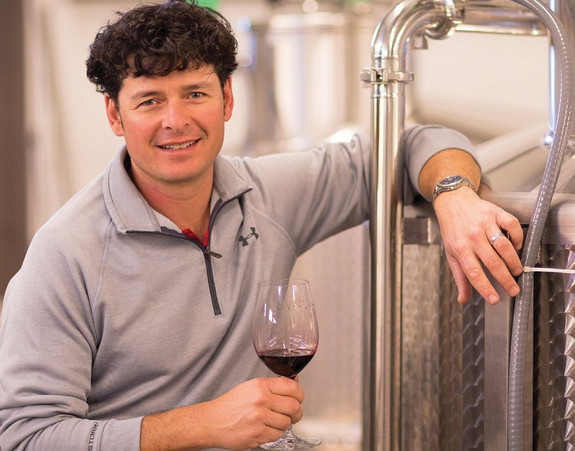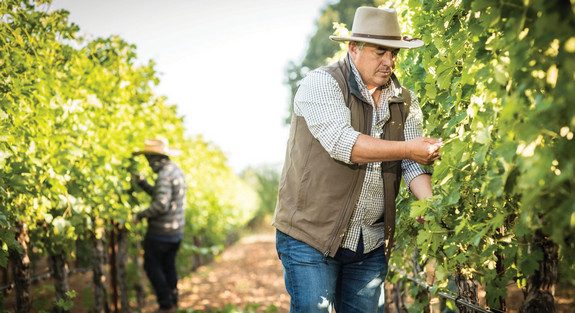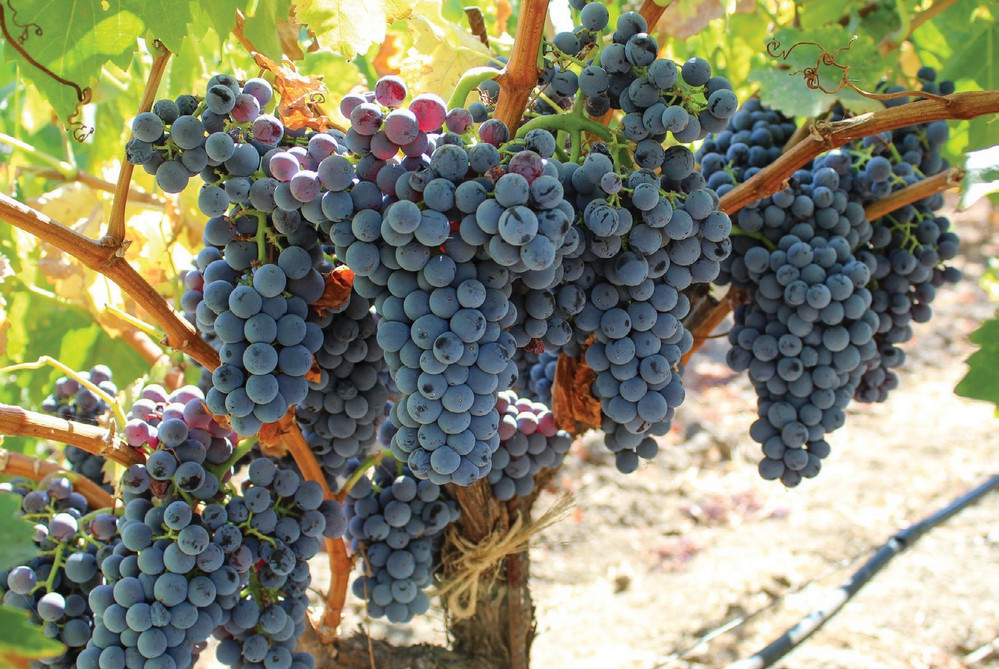Napa Valley Vintners Going Off the Grid with Non-Traditional Grapes
Cabernet Sauvignon is now the most widely planted wine grape in the world. This maSy not be such a big surprise, especially when considering Napa Valley. Cabernet put down its permanent roots in Napa Valley after surviving the double blows of phylloxera and Prohibition in the early 1900s. Today it rep- resents 50 percent of Napa Valley’s vineyard plantings with over 22,000 dedicated acres.
The king of red grapes earned its title because it is reliable, not difficult to grow, and is among the world’s most structured, complex, and age-worthy wines. But there are some wine producers who are recognizing the beauty of Napa’s underrated grapes and are welcoming the challenge of raising them in Cabernet country. These revisionists are setting out to prove there is more to Napa Valley than what one would expect.
RIESLING
At one time, Riesling was one of California’s most promising white grapes. It was widely planted with nearly 9,000 acres in the late 1970s. Today, only 4,000 acres remain across the state, with less than 100 acres in Napa Valley. Riesling can’t seem to hold its ground. This is a shame considering the grape’s wide appeal, especially among wine experts. Riesling delivers what no other varietal can – explosive fruit, exotic nuances, richness, plus its persistent acidity which makes it one of the most food-friendly wines.
 “Riesling has always been part of Stony Hill,” says Sarah McCrea, Marketing Director of Stony Hill Vineyard on Spring Mountain in Napa Valley, where Riesling vines date back to 1948. “My grandparents, Fred and Eleanor McCrea, were passion- ate about white varieties and Riesling was more a staple grape back then than it is today, so it was a natural fit.” As Napa Valley finds itself in an era of increasing Cabernet production, it’s refreshing to find a producer like Stony Hill that still gravitates towards less obvious grapes like Riesling. “Growing and producing Riesling in Napa Valley these days is pretty unusual. We love these wines and make them because we, and our longtime customers, love to drink them,” adds McCrea.
“Riesling has always been part of Stony Hill,” says Sarah McCrea, Marketing Director of Stony Hill Vineyard on Spring Mountain in Napa Valley, where Riesling vines date back to 1948. “My grandparents, Fred and Eleanor McCrea, were passion- ate about white varieties and Riesling was more a staple grape back then than it is today, so it was a natural fit.” As Napa Valley finds itself in an era of increasing Cabernet production, it’s refreshing to find a producer like Stony Hill that still gravitates towards less obvious grapes like Riesling. “Growing and producing Riesling in Napa Valley these days is pretty unusual. We love these wines and make them because we, and our longtime customers, love to drink them,” adds McCrea.
Stony Hill is not the only Riesling producer in Napa Valley that is fueled by passion as opposed to economics. Bouchaine Vineyard in the Carneros District is also known for its many small bottlings of unusual and unique wines, namely Riesling, Gewürztraminer, Pinot Gris, Pinot Meunier, and Syrah. Winemaker and General Manager, Chris Kajani believes if the grape grows well, and the wine tastes good, then the loyalty will come. “We just make what we like to make and don’t worry about the trends,” says Chris.
In fact, Chris and her team love playing and experimenting with Riesling so much that they planted some of their own on their Carneros property last year.
So far, their investment seems to be paying off. Bouchaine’s Riesling is a fan favorite at the winery and sells out every year. It has even been featured on the wine list at Michelin-starred restaurant, Michael Mina in San Francisco.
GRENACHE
 Perhaps one of the world’s most under-valued grapes is Grenache. Grenache has origins in Spain, and it is the leading grape in southern France where it is the backbone of renowned Châteauneuf-du- Pape wines. Grenache is difficult to grow and requires a lot of manual labor, but when given proper care it transforms into a wine with unmistakable richness, smooth texture, and refined taste. Sadly, Grenache plantings are scattered and small in Napa Valley. For wine industry legend, Tor Kenward of TOR Wines, finding Grenache doesn’t come easy. “Both me and my winemaker, Jeff Ames, have gone up and down California to chase down great Grenache sites. For us, it’s our passion to make the wine that leads us to chase the grapes,” says Kenward who currently produces 150 cases of Grenache from Palisades Vineyard in Calistoga. It is evident that Cabernet Sauvignon is the cash crop in Napa Valley, and for that reason Tor is always asked by business people why he chooses to make Grenache.
Perhaps one of the world’s most under-valued grapes is Grenache. Grenache has origins in Spain, and it is the leading grape in southern France where it is the backbone of renowned Châteauneuf-du- Pape wines. Grenache is difficult to grow and requires a lot of manual labor, but when given proper care it transforms into a wine with unmistakable richness, smooth texture, and refined taste. Sadly, Grenache plantings are scattered and small in Napa Valley. For wine industry legend, Tor Kenward of TOR Wines, finding Grenache doesn’t come easy. “Both me and my winemaker, Jeff Ames, have gone up and down California to chase down great Grenache sites. For us, it’s our passion to make the wine that leads us to chase the grapes,” says Kenward who currently produces 150 cases of Grenache from Palisades Vineyard in Calistoga. It is evident that Cabernet Sauvignon is the cash crop in Napa Valley, and for that reason Tor is always asked by business people why he chooses to make Grenache.
“The only reason I make Grenache is because I like Grenache,” explains Tor, “I make it for myself, my winemaker, and the people who taste it and fall in love with it. I make it for them.”
Unlike Kenward, Napa Valley Winemaker Rudy Zuidema became a Grenache producer by happenstance. The op- portunity arose when the owners of the Heritage McGah Vineyard in Rutherford, whom Rudy had been working with for a few years, was considering pulling out old Cabernet Sauvignon that was struggling. They consulted Rudy and several of the other vintners sourcing grapes from the property as to what they should plant, and the consensus was Grenache. “This was a hard sell being in the middle of Bordeaux country. But our commitment to the project and after a lot of wine, we convinced them. We grow it old- world style, keeping costs down by head training the vines and keeping it simple. Everyone seems pleased. The fruit coming out of McGah is exceptional.” says Rudy.

Rudy produces just 99 cases of Grenache for his wine label, Zuidema Wine Company. He loves Grenache because it is fun and versatile to drink.
“We’re a young family that’s on the go a lot. We don’t have time to make a beautiful reduction sauce to go with a big Cabernet, some- times its mac and cheese or leftover pizza and Grenache always fits.”
“It’s refreshing, fun, and easy and you don’t have to think about it. It fits so many different occasions and is far more appealing than Cabernet in that sense,” describes Rudy.
TEMPRANILLO
Spain’s most famous red grape is hard-pressed to find in Napa Valley. Tempranillo is a well-structured wine with a significant amount of tannin, generous acidity, and a distinct savory profile. With a structure that matches Cabernet Sauvignon, Tempranillo is a welcomed alternative for Rolando Herrera, Owner and Winemaker of Mi Sueño Winery. Seven years ago, Rolando received a phone call from a friend who offered him one acre of Tempranillo and he accepted the fruit without hesitation. “The first time I walked the Tempranillo vineyard, I observed everything and took it all in. I was so excited because very few people get to work with these grapes. I knew I was so lucky,” beams Rolando.

Rolando loves Cabernet but he explains how growing just Cabernet is boring not only for him as a winemaker, but for the consumer. To him, Tempranillo is really exciting and keeps winemaking interesting as the grape has so much to offer. Fun and passion cer- tainly seem to be the point of growing Tempranillo, especially when economics suggests Cabernet.
“People want something different, and when the whole world is looking towards Cabernet, our Tempranillo is standing out,” declares Rolando.
Vintner Brian Doody of 601 Cellars, a small production boutique label specializing in single-vineyard Napa Valley Sangiovese and Grenache, explains the Cabernet phenomenon best, “Regretfully so many Napa Valley growers and vintners are replacing some of the most beautiful fruit from the lesser-known varietals in favor of planting Cabernet Sauvignon. Let’s face it, a ton of grapes costs the same to produce, but growers can charge two to three times more for the Cabernet. As a result, Napa Valley Sangiovese, Grenache, and some of the other off the grid wines are turning into passion projects. We hope to see that change, however. We are finding a lot of wine drinkers are looking for approachable, quality wines they can pop open on Tuesday nights.” Now it seems im- portant to reinforce that Napa Valley is a diverse winegrowing region that is home to more than just amazing Cabernet. Besides Riesling, Grenache, and Tempranillo other non-traditional varieties such as Sangiovese, Petite Syrah, Malbec, Charbono and Chenin Blanc continue to thrive here and vintners continue to make it – not just because of their passion, devotion, and spirit to cultivate it, but also for those who want to drink it.
Where to find them:
Riesling:
Bouchaine
Smith Madrone
Stony Hill Vineyard
Trefethen Family Vineyards
Grenache:
601 Cellars
TOR Wines
Zuidema Wine Company
Tempranillo:
Mi Sueño Winery
Vincent Arroyo
BY: MARISA MCCANN

